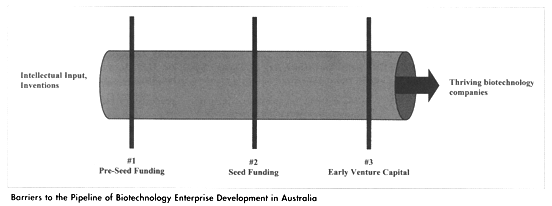
|
Australasian Biotechnology (backfiles)
AusBiotech
ISSN: 1036-7128
Vol. 11, Num. 3, 2001, pp. 22-23
|
Untitled Document
Australasian Biotechnology, Vol. 11 No. 3, 2001, pp. 22-23
BIOTECHNOLOGY FUNDING
BIF - OVERCOMING ONE CRUCIAL BARRIER IN THE DEVELOPMENT OF ENTREPRENEURIAL
BIOTECHNOLOGY COMPANIES
John Ballard, Vice President
AusBiotech Ltd
Code Number: au01039
The Biotechnology Innovation Fund (BIF) program recently introduced by the
Federal Government will enable start-up companies to secure competitive grants
of up to $250,000 on a dollar-for-dollar matching basis. The provision of this
proof-of-concept or seed funding may help overcome one of the key barriers to
enterprise development.
Barriers to Enterprise Development
From the stage where a significant invention has been made until a venture
capital-backed company is exploiting that invention, worldwide experience has
shown that three commercial barriers must be removed or overcome.
These barriers can be visualised as valves in a pipeline (see Figure) whereby
all three must be opened for flow to occur. The barriers or valves are:
- lack of suitable pre-seed structures and resources in universities and other
public sector institutions;
- absence of the seed capital needed to take a new enterprise to the proof-of-commercial-concept
stage at which venture capital can be attracted;
- insufficient venture capital targeted at early stage companies ('start-up
capital') that can move these companies towards commercial business operations.
As recently as three years ago all three barriers were firmly in place here
in Australia. For that reason, few biotechnology companies were established
and those that were successful had to overcome the financial barriers through
a means that was not looked on favourably elsewhere in the world - having a
cash-flow business to support the development of their pharmaceutical opportunities.
AMRAD, Progen, Bresagen and GroPep took this route.
In 1998 the Commonwealth Government established the Innovation Investment Fund
(IIF) program through which fund managers are heavily subsidised to attenuate
the risk inherent in early stage investments. Six IIFs (AMWIN, Coates Myer,
Rothschild, Nanyang, Start-up Australia and Newport) with approximately $250
million available for investment, have a substantial focus in the biotechnology
sector. Together these venture capital funds have helped overcome barrier #3
by providing start-up capital. Indeed the situation is even more positive with
at least three Pooled Development Funds (PDFs), Medica, Starpharma and Biotech
Capital together having $100 million available for early-stage investments in
biotechnology companies. A number of other Venture capital funds indicate their
preferred business investment is at the barrier #3 stage.
| Box 1. Summary of the BIF Program |
| Scope: |
Competitive grant support to Australian companies that addresses
the gap in the commercial path between research and the attraction of private
investment for commercialisation. |
| Field: |
Biotechnology broadly defined to include medical devices,
bioprocess engineering, biomembranes, cell and tissue culture, bioinformatics,
development of drug manufacture as well as protein and genetic engineering
technologies. |
| Intellectual Property: |
Must be owned or controlled by the company. |
| Funding: |
Up to $250,000 over 18 months, which must be matched 1:1
with cash from applicants. State and Commonwealth government funds may be
used for matching, with some exclusions to eliminate double-dipping. |
| Merit Criteria: |
Preference to start-up companies; leading-edge biotechnology;
commercial and national benefits; demonstrated need for funding; the company's
own funds (not only government's) at risk; at least 25% private ownership
of the company. |
| Selection Process: |
First round of applications closes 30 June, 2001; subsequent
rounds every 3 months. Competitive selection is administered by the Biological
Committee of the IR&D Board. A total of $20 million is available for
the program over 3 years; another $20 million has been approved but not
yet allocated. |
| Program Administration: |
Very much like R&D START, managed by AusIndustry. |
How BIF will Address Barrier #2
Obtaining capital funds at the seed stage (barrier #2) is traditionally much
more difficult because the commercial risk is perhaps an order of magnitude
greater. Many US states address the problem by providing $250,000 - $500,000
to companies once the enterprise has attracted a modest amount of private seed
capital. These payments are typically in exchange for equity rather than as
grants. An important issue for the US state investment funds is that due diligence
must first be carried out by the private investor, thus limiting the workload
of the state groups and reducing the time between an application and receipt
of an offer to just a few weeks.
BIF differs from the usual US model of seed funding because cash is provided
as a grant for a project rather than to develop the enterprise. Otherwise most
features of BIF (see box 1) are similar to other seed funding arrangements.
Moreover, any difference between a BIF project and support of an enterprise
may be more illusory than real because the project may very well be proof-of-concept
for the enterprise. In support of this, a stated key objective of BIF is to
address the gap in the commercialisation path between research and the attraction
of private investment. Because investors almost always inject funds to purchase
equity, and equity in projects rather than in enterprises requires a complex
financial structure, it is likely that many if not most successful applicants
for BIF support will be aiming for the development of their company as a whole,
rather than a project within that company.
The Future: Addressing Barrier #1
The remaining barrier that faces any developing biotechnology enterprise is
actually the earliest one in time sequence, viz. the lack of suitable pre-seed
arrangements.
Our universities and research institutions need to move forward by: introducing
a 'can-do' entrepreneurial culture amongst their staff, providing pre-seed
financial support to their inventions, adopting transparent policies whereby
staff can be seconded as key personnel into a new company and encouraging share
ownership by staff in companies that arise from their inventions. Until these
are addressed, real impediments to the formation of spin-out companies will
remain.
The "Pre-Seed Fund", announced as part of the Australian Government's
Innovation Action Plan, is being set up to specifically address the problems
associated with barrier #1. While the fund is not restricted to biotechnology,
experience elsewhere in the world is that most of the focus of any pre-seed
fund is likely to be in the biotechnology and IT sectors.
At this stage in its development, the Pre-Seed Fund is planned to be delivered
by private sector fund managers. In this sense it would be like the IT-specific
BITS program or the IIF. A possible scenario is that the fund managers could
be agencies more akin to incubators with staff who truly understand the specific
research areas being targeted.
AusBiotech will continue to make representations to government so that the
finalised Pre-Seed Fund will be developed to serve the needs of our members
and the broad biotechnology community in the best ways possible. It is a critical
$78 million initiative that we must not allow to fail.

Behind the Scenes Representations by AusBiotech
Over the past two months, your Board and Executive Director have had numerous
discussions with Biotechnology Australia and other Industry, Science and Resources
staff to help fine-tune the draft BIF proposals. The objectives of these representations
have been to modify the program so that it incorporated a broad definition of
biotechnology relevant to all our members, to introduce suitable dollar-matching
and equity arrangements and to adopt appropriate merit criteria for selection
of successful applicants.
Although not all of our proposals were adopted, ISR has at all times been receptive
to constructive suggestions. We also understand that the second $20 million
allocated to BIF (only the first $20 million is available under the present
scheme) is likely to address any deficiencies in the program that are identified
during the first two granting rounds.
Relationship to Other Commonwealth Funding Programs
Box 2 lists the existing Commonwealth funding programs that apply to biotechnology
research and commercialisation. The programs are separated into those that support
enterprise development (typically equity-based funding) and those that finance
R&D. With the exception of the tax incentive and tax rebate schemes, all
the R&D support is provided as grants. The industry-targeted grant schemes
require matching funds.
BIF is a hybrid of both types of arrangements because it is on the one hand
a grant program that does not necessarily involve a substantial R&D component
and on the other addresses enterprise development. A principal goal is to make
a company ready for venture capital investment and in that sense it is more
similar to BITS.
The Pre-Seed Fund is also likely to be a hybrid involving components of both
Enterprise and R&D support. While directed at public sector research institutions,
it will foster new companies and may fund some R&D.
| Box 2. Existing Australian Government Funding
Programs Relevant to Biotechnology |
| Support of capital items such as the Major National
Research Facilities program and Commonwealth agencies that do not provide
support externally (e.g. CSIRO) are not summarised below. |
| Enterprise Support
Assist the establishment or expansion of commercial enterprises. Funding
is provided in return for equity
Funds R&D activities in the public sector or in companies. Support
is in the form of competitive grants except for those schemes that provide
tax deductions or rebates
- COMET
A non-sectoral program that supports newly formed companies to become
investment-ready. In practice the focus is on non-technological enterprises
and excludes expenditure on R&D. Maximum support $100,000.
- BITS
Seed-capital funding program. Only those biotechnology companies with
a strong IT component (e.g. bioinformatics) are likely to be eligible.
- IF
Government supported venture capital investment program targeted at
funding the first round of VC investments. Inputs are typically $1-3million.
|
R&D Support
- NH&MRC, ARC, Rural R&D Corps
Grants supporting early stage research in Universities and other public
sector institutes
- SPIRT
Support for university research with matching project-by-project
funding from the private sector
- CRC
Substantial (typically $20million) grant funding of University-research
institute - private sector consortia over 7 years for research, training
and commercialisation. Required matching is about $3 for each $1 of
program funds.
- R&D START
Supports R&D projects of clear commercial relevance in SMEs
and larger companies. Must be matched 1:1. Maximum support $15million.
- R&D Tax Concession
Non-competitive programs offering tax concessions to profitable
companies or rebates to those companies that are in a tax-loss situation
|
Copyright 2001 - AusBiotech
| 